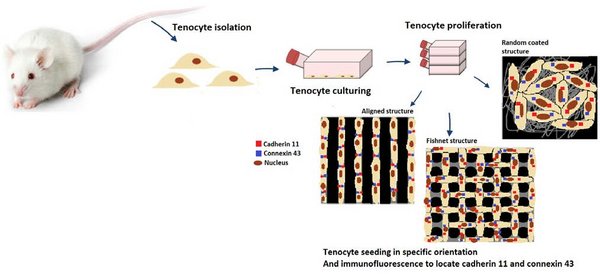
The most common chronic tendon disorder is tendinopathy. The healing of these tendinopathic tendons is difficult and poorly understood. To find a way to get a tendinopathic tendon back to its native structure and function, the basic structure of tendons should be understood. In a tendinopathic tendon the extracellular matrix (ECM) changes from a highly organized, aligned tissue to a more random organized, tendinopathic tissue. This causes the tendon to lose its native structure and function. Important adherens junctions and gap junctions are cadherin 11 (cdh-11) and connexin 43 (cx-43) proteins. These proteins play a big role in the aligning of the extracellular matrix, and therefore are a target for research. In this study an in vitro model is used to simulate the in vivo situation of a healthy and a tendinopathic tendon. Murine tenocytes, of a 7-9 weeks old mouse tail, were cultured and seeded on an aligned, fishnet or randomly coated collagen substrate, printed via micro-contact printing of collagen type 1. With immunocytochemistry and fluorescence microscopy the location of cx43, cdh-11, nucleus and actin cytoskeleton were studied in the in vitro model. In case of aligned collagen, the cytoskeleton was aligned with the collagen. On the fishnet and random coated collagen, the cytoskeleton orientation was more randomly. The cx-43 and cdh-11 protein locations were observed near the membranes of adjacent cells for aligned structure, while for fishnet and random coated structures, the location was more spread throughout the whole cell. Therefore, it can be concluded that the seeding of tenocytes on the aligned collagen substrate of the in vitro model has the most similarities with the tenocytes of an in vivo healthy tendon. However, it should be taken in mind that the in vitro model is too simple to representative the in vivo situation.